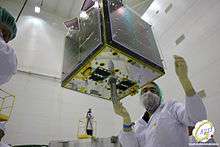UniSat-6
 UNISAT-6 Mission Patch | |
| Mission type | Technology demonstration |
|---|---|
| Operator | GAUSS Srl |
| COSPAR ID | 2014-033C |
| SATCAT no. | 40012 |
| Website | GAUSS Srl page on UniSat-6 mission |
| Spacecraft properties | |
| Launch mass | 26 kg (57 lb) |
| Start of mission | |
| Launch date | 19 June 2014 |
| Rocket | Dnepr |
| Launch site | Dombarovsky site 13 |
| Orbital parameters | |
| Reference system | Geocentric |
| Regime | Sun Synchronous |
| Eccentricity | 0.005957 |
| Perigee | 610 km |
| Apogee | 694 km |
| Inclination | 97.93 ° |
UniSat-6 is an Italian micro-satellite developed by GAUSS Srl and launched in 2014. The satellite is built in a 0.4x0.4x0.4m box-shaped bus, optimized for piggy-back launch. All instruments are powered by solar cells mounted on the spacecraft body, with maximal electrical power of 11W. The satellite has no on-orbit propulsion, it makes use of an attitude stabilization system based on permanent magnets.[1]
Launch
UniSat-6 was launched from Dombarovsky (air base) site 13, Russia, on 19 June 2014 by a Dnepr rocket.
Mission

The satellite is intended primarily for technology verification in space, the main test piece being 3 deployment systems loaded with 4 CubeSat satellites, namely AeroCube 6, Lemur 1, ANTELSAT and Tigrisat,[2] with a total volume 9U. All sub-satellites were deployed 25 hours after achieving orbit, without incidents.[3]
The satellite is also equipped with an on-board camera to take pictures of the release of the cubesats and for Earth Observation.
See also
References
- ↑ http://space.skyrocket.de/doc_sdat/unisat-6.htm
- ↑ "Archived copy". Archived from the original on 2015-09-25. Retrieved 2015-09-25.
- ↑ http://www.gaussteam.com/unisat-6-cubesat-release-accomplished/
External links